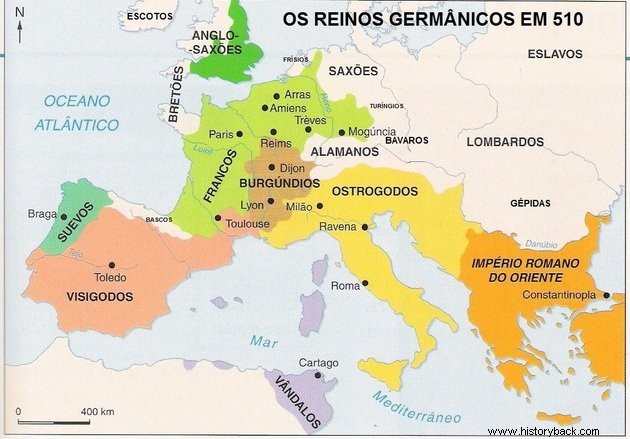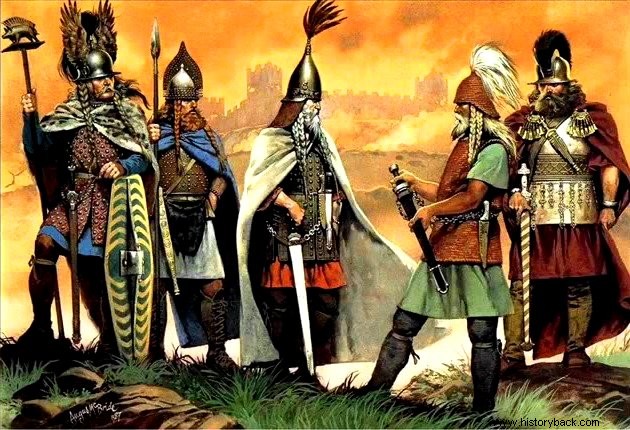TheGermanic peoples are Indo-European ethnicities originally established in Northern Europe.
The greatest source of knowledge we have of the Germans dates from the rule of Julius Caesar (100 BC - 44 BC), when the Roman Emperor waged several wars against these peoples.
Origin
The Germanic peoples inhabited northern Europe, where countries such as Germany, Austria, Denmark, Norway, Sweden, the Netherlands, Belgium, Luxembourg, the United Kingdom and part of France are located today.
As they had no alphabet, there are no sources written by the Germanic tribes themselves. Therefore, archaeological evidence is essential to discover how these peoples lived.
Check the map below where the main Germanic kingdoms were located:

Germanic Tribes
The main Germanic tribes are:
- Alamannos
- Alans
- Bavarians
- Franc
- Friesians
- Lombards
- Normans
- Ostrogoths
- Saxons
- Suevi
- Vandals
- Vikings
- Visigoths
Social Organization
We found the division of labor by sex with the woman being responsible for the work in the field, in the house and for weaving. They wore clothes made of wool or cloth, which could be white, black and even dyed red.
Men, in turn, were busy with herding, hunting and war. This was a constant activity, as the tribes lived at war with each other.
Despite the division of labor between the sexes, women occupied a special place within the tribal hierarchy, as they were priestesses, healers, midwives and seers.

Political Organization
Before the consolidation of the Germanic Kingdoms – after the fall of the Roman Empire – the organization of the tribes did not have a rigid hierarchy.
Kings, warlords and priests had circumstantial and consensus-based power. It was common for decisions to be taken unanimously through acclamations in assemblies of free men.
The family group was very supportive and collectively responsible, especially to take revenge or pay the wergeld .
This was a striking feature of Germanic law. If a person was killed or injured, the clan could do the same to the attacker. If wergeld did not materialize, the tribes incurred a blood debt to the other clan.
Houses and Food
The Germanic tribes lived in communal houses, built of wood and clay, where men and animals lived. A tribe had no more than 20 houses.
They fed on nuts, roots and tubers. Their main activity was herding, but they rarely ate meat.
The Germanic peoples practiced agriculture and left large spaces of free land around their tribes, which served as pasture for their cattle.
German Mythology
Germanic mythology is very similar to Norse mythology, to the point that some scholars use the terms synonymously.
They worshiped various gods who personified the nature, virtues and defects of men as was customary in paganism.
For this reason, we find the Valkyries, and the gods Odin, Thor and Freya, as they exist in Scandinavian legends.
See also:Norse MythologyContact with the Roman Empire
The first written sources on the Germans come from the observation of the Emperor Julius Caesar and the historian Tacitus, author of the book "Germania ".
Emperor Julius Caesar described the Suevi this way:
It was Caesar who called all inhabitants east of the Rhine "Germanic." However, the Germanic tribes were far from being a homogeneous block and some were even enemies with each other.
Fall of the Roman Empire
Despite constant wars and invasions, some Germanic tribes were part of the Roman Empire as federated members or were hired as mercenaries.
However, the weakening of the Roman army and the expansion of the Germanic tribes ended up defeating the Empire when Rome was conquered in the year 476.
Each tribe settled in different parts of the ancient empire, adapted Roman law to their reality and little by little they were Christianized. This merger will give rise to the Holy Roman Empire.
See also:Slavic Peoples